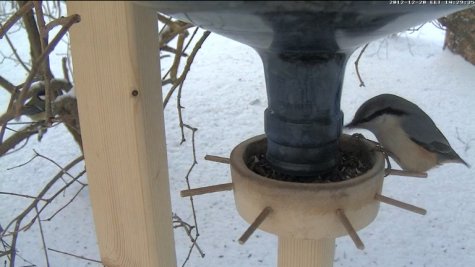Winter bird feeder webcam - nuthatch
Screencap Max W, LK forum
Translation: Liis
Eurasian nuthatch Puukoristaja Sitta europaea
Nuthatches are extremely true to their nesting area, guarding their territory throughout the year; quite often we see a couple in action near the feeder.
A nuthatch has a streamlined body, the tail is short. Blue-grey crown and back, underparts are off-white, and the flanks and undertail coverts reddish-brown. Long, strong beak, black eye stripe. Female and male birds look similar. The only one of our birds that can move on tree trunks head downwards and without using the tail as support as woodpeckers and the treecreeper do. The legs of the nuthatch are short, with toes that can be spread out very wide, and long and strong claws to help the acrobat in its movements. On the ground it moves by jumps.
An early-morning bird feeder visitor who picks up several seeds in the beak, to hide them or eat somewhere in peace. When the nuthatch arrives the hotheads calm down, the boss is there – it is quite amazing. An alert creature, as the tits with whom it often keeps company. Seeds of all kinds will do as food as well as lard. If you have a nice oat sheaf hanging somewhere it is often the nuthatch’s favourite.
The nuthatch is a dare-devil bird – it fear´s neither man nor cat and knows its home area and its inhabitants thoroughly. Who has time and interest can train a nuthatch to eat out of the hand.
The winter number is estimated at a hundred to two hundred thousand birds, including the ones arriving from the north. To our western islands the nuthatches rarely arrive. As for weight a little heavier than our largest tit, the great tit – just over twenty grams. Body length less than fifteen centimetres.









